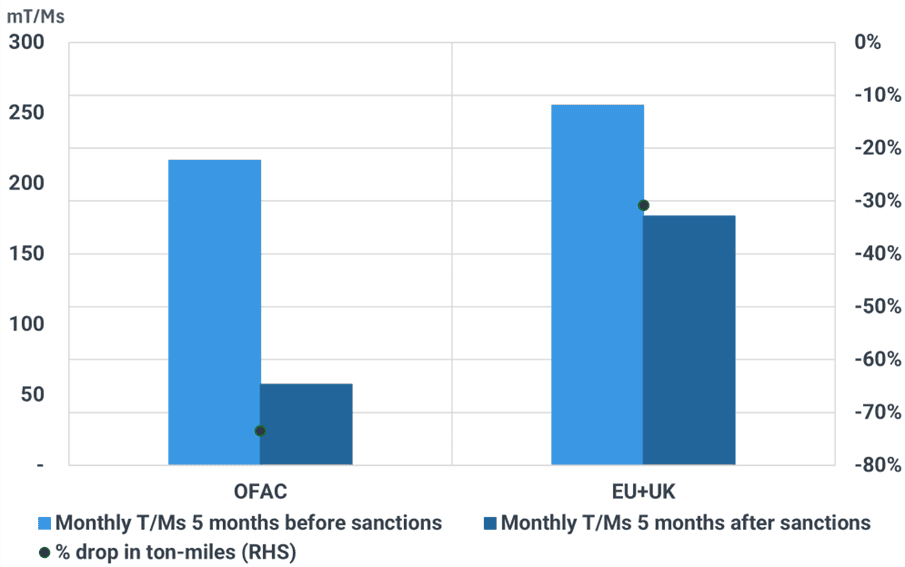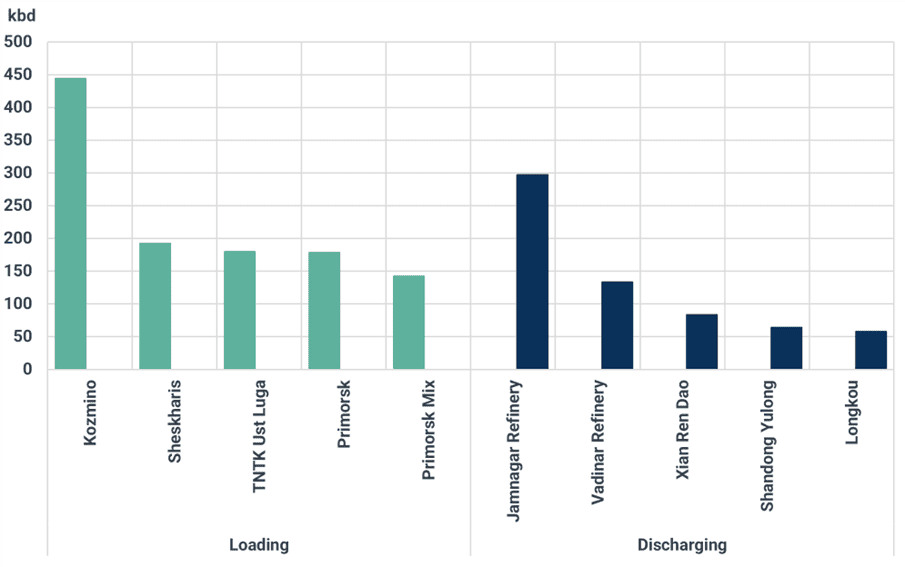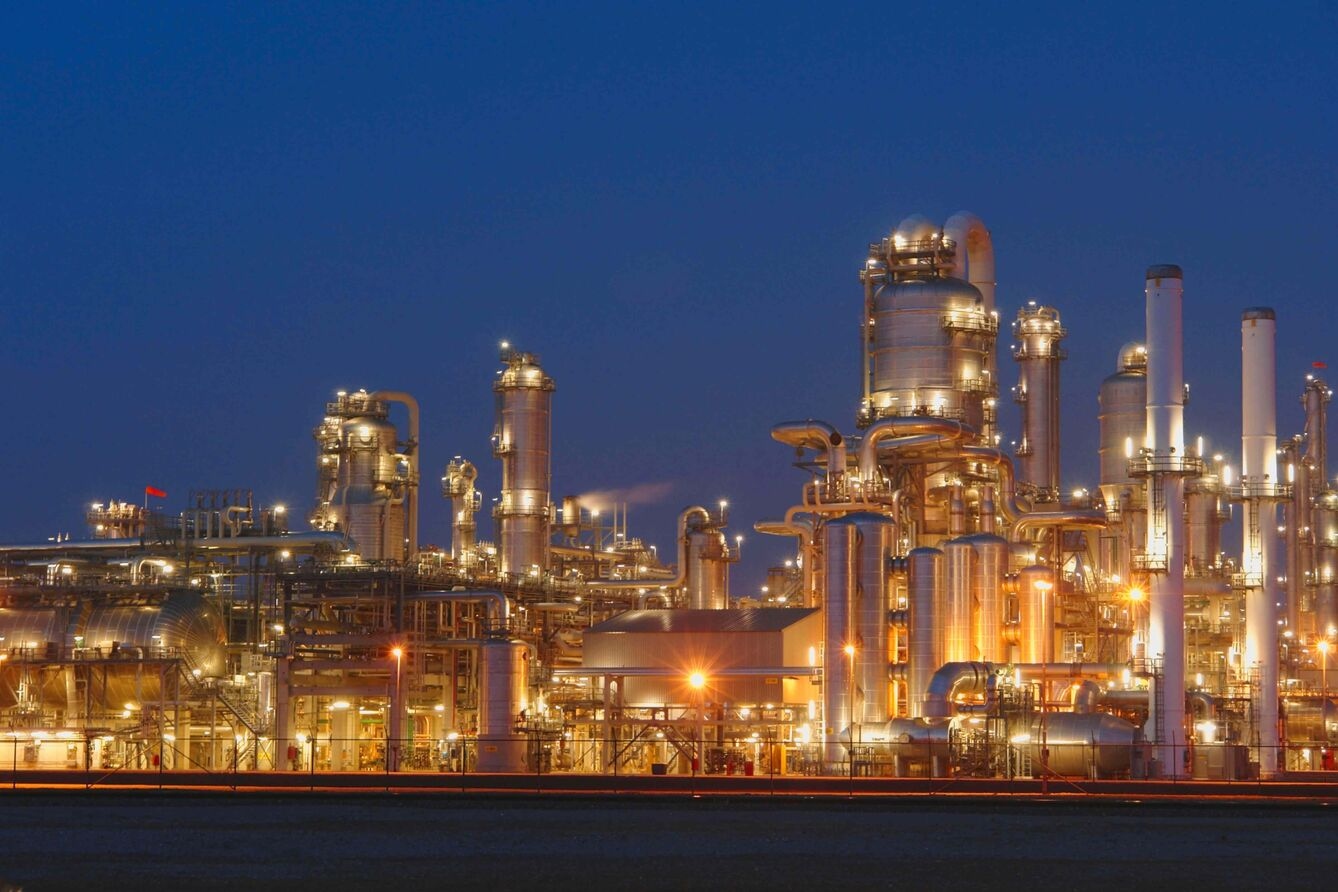Assessing the impact of sanctions on Russia’s shadow fleet
Russia has sustained its crude exports despite the logistical challenges posed by the recent escalation of sanctions targeting shadow fleet tonnage. US sanctions are assessed as far more effective, causing double the productivity decline in vessels, compared to EU/UK sanctions. OFAC-sanctioned vessels ship Russian crude primarily from eastern ports to China, while EU/UK-sanctioned ships serve India.
Market and trading calls:
- Russia has sustained its crude exports despite the logistical challenges posed by the recent escalation of sanctions targeting shadow fleet tonnage.
- US sanctions are assessed as far more effective, causing double the productivity decline in vessels, compared to EU/UK sanctions.
- OFAC-sanctioned vessels ship Russian crude primarily from eastern ports to China, while EU/UK-sanctioned ships serve India.
On October 15, the UK government announced a new round of sanctions targeting Russia’s oil industry, adding, among other entities, over 40 tankers operating within Russia’s so-called “shadow fleet” to its sanctions list. This action marks a continuation of the escalation in sanctions throughout 2025, as both the UK and EU intensify efforts to curb Russia’s oil exports by expanding restrictions on vessels involved in the trade.
Russia’s shadow fleet over time

Source: Kpler
In contrast, OFAC’s relative inactivity has been notable. The most recent U.S. sanctions package, which explicitly targets shadow fleet vessels, dates back to January 25, under the previous U.S. administration. As a result, only around 40% of vessels currently sanctioned in connection with Russian crude oil are under OFAC restrictions, with the EU and UK accounting for the majority.
These developments come as Russian crude exports reached a new seasonal high of 3.7 mbd in September 2025, following Ukraine’s successful drone strikes against Russian refineries, which placed approximately 1.6 mbd of refining capacity under unplanned maintenance.
During the same period, the price cap on Russian crude was reduced to $47.60/bbl, rendering Urals crude trades non-compliant after roughly six months of operating within legal bounds, though some compliant cargoes probably spilled over into September. This adjustment should, in theory, have created additional challenges for Russia in securing adequate tanker capacity, as “under-the-cap” carriers gradually withdrew from its crude trade.
Taken together, these developments raise important questions regarding the overall effectiveness of the current sanctions and their ability to achieve the intended constraints on Russia’s oil export capabilities.
Our analysis indicates that the impact of sanctions on tanker productivity and employment varies significantly depending on the sanctioning body. Comparing a vessel’s productivity as described by ton-miles, before and after inclusion on sanctions lists demonstrates that OFAC sanctions are by far the most effective. According to research conducted by Kpler, vessels added to OFAC’s lists experience an average productivity decline of 70%. In comparison, vessels sanctioned exclusively by the EU or UK see a much smaller reduction, estimated at 30%. This suggests that Russia’s trading partners are more hesitant to challenge US institutions, possibly reflecting significant exposure to the US dollar for trade and financing.
Drop in vessel’s ton-miles (T/Ms) post-sanctions

Source: Kpler
Nonetheless, the degree of caution differs considerably between the two major importers of Russian liquids, namely India and China. By isolating vessels sanctioned exclusively under OFAC’s Russian programs and analyzing their port calls during the third quarter of 2025, we observe that Russia’s eastern ports dominate as loading hubs. Sakhalin and Kozmino lead in port activity, with Sheskharis being the only western terminal with notable traffic. It is essential to note that the January 10 OFAC sanctions primarily targeted ESPO trade, which explains why a larger number of vessels from Eastern Russia fall under OFAC restrictions compared to those in the Western region. The inclusion of Kharg Island in sanction lists underscores the blurring boundaries between “shadow” and “dark” fleets, as parallel trades expand and more vessels face restrictions. On the discharging side, Chinese ports dominate, with four terminals ranking among the top destinations.
Top 5 calls by OFAC-sanctioned vessels under Russian programmes Q3-25

Source: Kpler
In contrast, vessels sanctioned solely by the EU and UK show a different pattern. While Eastern Russia’s Kozmino emerges as the leading export terminal, a significant share of these vessels continues to operate in major western terminals, particularly in the Baltic region. Most notably, on the import side, India overtakes China as the top destination for cargoes carried on EU- and UK-sanctioned tankers. The appearance of Vadinar, home to EU-sanctioned Nayara refinery, comes perhaps as little surprise. The EU imposed sanctions on Nayara Energy as part of its 18th sanctions package targeting Russian oil and energy revenues back in July, with the UK following suit in its latest round of sanctions. Examining the broader picture, just 0.5% of India’s crude imports were transported on an OFAC-sanctioned vessel, limited to a tanker permitted to discharge only a few days after being listed, whereas the share rises to 18% for vessels sanctioned by the EU and UK.
Top 5 calls by EU/UK-sanctioned vessels under Russian programmes Q3-25

Source: Kpler
This suggests that, unless OFAC keeps up with the EU and UK, Russia appears well-positioned from a tonnage perspective to sustain crude exports, including any surplus created by refining disruptions.
Market insights you can trust
Kpler delivers unbiased, expert-driven intelligence that helps you stay ahead of supply, demand, and market shifts.
Trade smarter. Request access to Kpler today.

Uncover risks before regulators do
See Kpler's Risk & Compliance insights in action.








